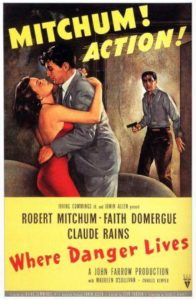She’s tempting to look at – dangerous to know!
In spite of the unique quirks and challenges of the Howard Hughes era of RKO Pictures, Robert Mitchum always seemed to overcome and deliver strong product. 1950’s Where Danger Lives is no variant from most of RKO’s releases from the same era.
Robert Mitchum is first billed as Dr. Jeff Cameron, a slight departure from Mitchum’s more brawny roles of the period. Though not completely miscast here, most of the strength of his character is intellect and deduction.
His female lead is Faith Domergue, and here is where the wondrous miasma of Hughes’ RKO shows its hand. Domergue was signed with Warner Brothers when Hughes met her at a party. In typical Hughes style, he became smitten with her and beginning a torrid relationship with her, buying out her contract with Warner’s and setting her up as his next new great find.
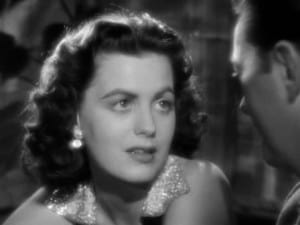 But Domergue had little screen experience, with only a few small and mostly uncredited roles to her credit. Her only leading role was the disastrous 1950 RKO picture Vendetta, which though filmed in 1946-7 wasn’t released until 1950. Though she endured to have a modestly successful career, here she is woefully miscast with the film suffering for it, with her clear lack of experience contributing visibly.
But Domergue had little screen experience, with only a few small and mostly uncredited roles to her credit. Her only leading role was the disastrous 1950 RKO picture Vendetta, which though filmed in 1946-7 wasn’t released until 1950. Though she endured to have a modestly successful career, here she is woefully miscast with the film suffering for it, with her clear lack of experience contributing visibly.
Rounding out the key players are Claude Rains and Maureen O’Sullivan, who both do outstandingly well though in woefully underutilized roles.
Where Danger Lives is a relatively pedestrian noir saved by Mitchum and wonderful direction by John Farrow. Farrow’s flair for composition and limited use of some of the more clichéd visual accoutrements of the genre make the film an enjoyable and face-paced affair.
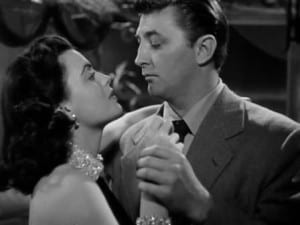 Mitchum the good doctor is the typical doctor (in the good way) though perhaps a bit on the soft side when it comes to common sense. He is well liked by his peers and has a semi-serious relationship with Julie, one of the nurses (O’Sullivan). On his way out to meet her one night, he is called back into the operating room one last time to help a suicide victim.
Mitchum the good doctor is the typical doctor (in the good way) though perhaps a bit on the soft side when it comes to common sense. He is well liked by his peers and has a semi-serious relationship with Julie, one of the nurses (O’Sullivan). On his way out to meet her one night, he is called back into the operating room one last time to help a suicide victim.
He saves her, learning that her name is Margo in the process. Almost immediately he falls for her and vice versa. She seems a bit mysterious and talks often of her onerous father, with whom she lives, but they decided to get married anyway.
After tying a few too many on (now here is the Mitchum we know) he decides to go over to her home, confront the father, and announce his intentions to marry Margo. He and the father, Mr. Lannington (Claude Rains) talk over a drink, and Dr. Chandler learns finally that Lannington isn’t her father at all, but rather her husband.
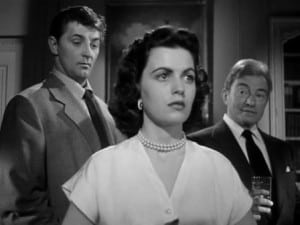 As Rains begins to prophetically warn of the road ahead for the new couple, a scuffle breaks out and Mitchum knocks him to the ground. After checking that the now unconscious Rains is still breathing, Mitchum heads into the bathroom to fetch some water to revive him.
As Rains begins to prophetically warn of the road ahead for the new couple, a scuffle breaks out and Mitchum knocks him to the ground. After checking that the now unconscious Rains is still breathing, Mitchum heads into the bathroom to fetch some water to revive him.
When he returns Rains is dead. Thinking himself the murderer and suffering from a self-diagnosed concussion himself, Cameron and Margo hit the road and head for Mexico to escape justice. As they head through the Southwest, Cameron’s head continues to worsen and paralysis begins to set in.
Finally at the border and with his left side now sluggish and stiff, Mitchum realizes what the audience has known all along. Margo killed her husband in the few minutes that Cameron took to fetch water, but let him take the fall.
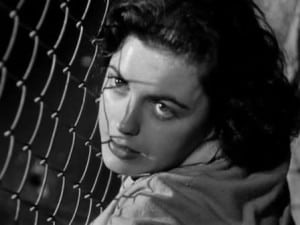 With her ruse up, Margo drops any pretense of sanity and makes to cross the border after murdering Cameron as well. This time though Margo didn’t hold the pillow down long enough and Cameron comes too, shuffling along the street in time to left Margo take a shot at him. Seconds later she is shot a killed by the police, still clutching the fence marking the border into Mexico.
With her ruse up, Margo drops any pretense of sanity and makes to cross the border after murdering Cameron as well. This time though Margo didn’t hold the pillow down long enough and Cameron comes too, shuffling along the street in time to left Margo take a shot at him. Seconds later she is shot a killed by the police, still clutching the fence marking the border into Mexico.
The plot is pretty typical and doesn’t give the audience much credit. We know Margo is the killer and the variety of tells and situations which are dropped into the run for the border sequences become more and more outlandish- though somehow the picture’s appeal isn’t diminished.
A car salesman sells Mitchum a truck in trade for what all know to be a stolen vehicle. The new couple- on the run, mind you- stumble upon a town in the middle of a wild west celebration of sorts. And anyone not in suitable garb is arrested. This they duly are, with the result being that they are married and shown to a hotel room, but not before the police get a picture of Margo and draw a beard and mustache on her: with her standing in the same room with them. Once in the hotel room, Margo destroys a radio after a news report comes on detailing her past psychological issues.
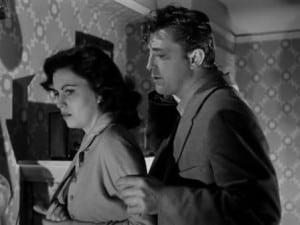 Which brings us back to the need to suspend believe a bit here. It is hard to see what is so alluring in Margo that leads Cameron to give up all and run away with her? Yes, she’s certifiably crazy but wouldn’t a trained doctor have at least some doubts about rushing into a relationship with a suicide victim? Surely one would proceed with caution, but again perhaps that’s just me.
Which brings us back to the need to suspend believe a bit here. It is hard to see what is so alluring in Margo that leads Cameron to give up all and run away with her? Yes, she’s certifiably crazy but wouldn’t a trained doctor have at least some doubts about rushing into a relationship with a suicide victim? Surely one would proceed with caution, but again perhaps that’s just me.
It’s sad that neither Claude Rains or Maureen O’Sullivan were used for more than a few scenes- with Rains getting only one. Even with their limited screen time both contribute to the saga, with O’Sullivan’s trusting glances making her abandonment (and her ultimate reconciliation) by Mitchum even more perplexing.
Rains dominates his one scene as was obviously intended as part of his character, but it is clear that for those few minutes, he is the star on the screen. Sadly, his only other appearance is a few sound-bites later on as Mitchum’s head begins to clear and he recalls some of the warnings uttered before their scuffle.
 With Mitchum and the supporting cast in tow however, much of the nitpicking of the plot isn’t needed as his naturally droopy eyes flow into his character. Coupled with suitably vexing camera angles and deep shadows which are wondrously shot, Where Danger Lives is well worth the price of admission in spite of a few plot holes and a woeful performance by Ms. Domergue. Except for one rather clichéd sequence towards the end (with the over used flash of a neon sign visible through the blinds), Director Farrow creates a visibly disturbing and nigh on nightmarish environment to supplement the state of Mitchum’s traumatized mind onscreen.
With Mitchum and the supporting cast in tow however, much of the nitpicking of the plot isn’t needed as his naturally droopy eyes flow into his character. Coupled with suitably vexing camera angles and deep shadows which are wondrously shot, Where Danger Lives is well worth the price of admission in spite of a few plot holes and a woeful performance by Ms. Domergue. Except for one rather clichéd sequence towards the end (with the over used flash of a neon sign visible through the blinds), Director Farrow creates a visibly disturbing and nigh on nightmarish environment to supplement the state of Mitchum’s traumatized mind onscreen.
